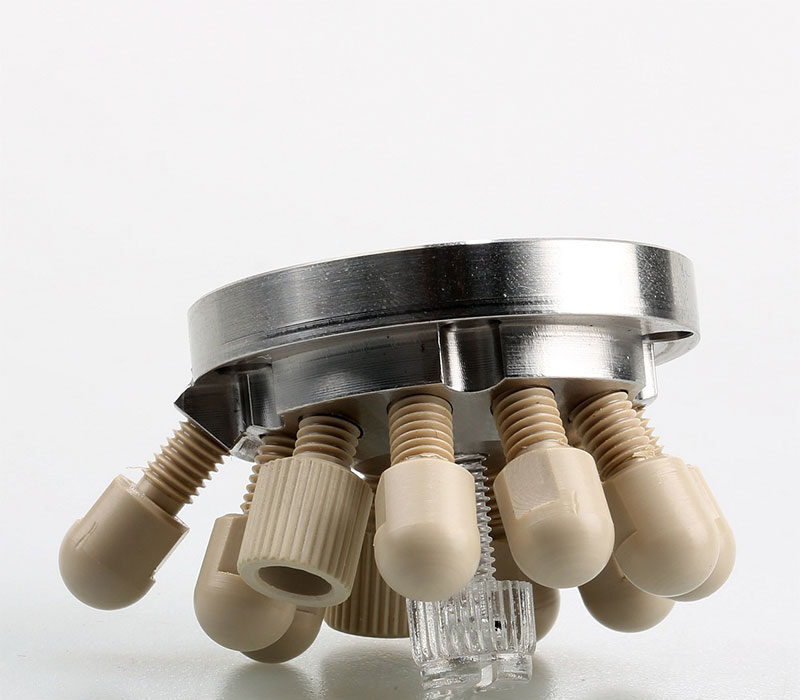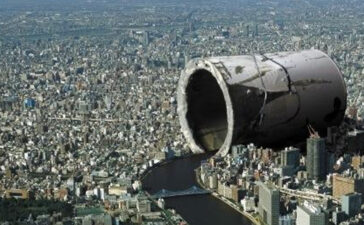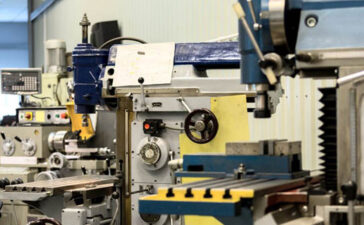Problems and solutions often encountered in the maintenance of plastic mold processing
1. Pay attention to the punch before use
- ① Clean the punch with a clean cloth.
- ② Check if there are scratches or dents on the surface. If there is, use oil stone to remove.
- ③ Oil and prevent rust in time.
- ④ When installing the punch, be careful not to have any tilt. Use a soft material tool such as a nylon hammer to lightly tap it. Only after the punch is correctly positioned can the bolt be tightened.
2. Installation and commissioning of the die
The installation and adjustment of the die must be very careful. Because the die is especially large and medium-sized, it is not only expensive, but also difficult to move due to its large weight. Personal safety should always be the first priority. For the die of the infinite device, a pad of wood should be added between the upper and lower dies. After the punching table is cleaned, place the mold to be tested in the closed state on the table. According to the process document and die design requirements, the selected slider stroke of the press is adjusted to the position of the bottom dead center before the mold is moved to the stage and is greater than the mold closing height of 10 to 15mm. Adjust the slider connecting rod to move the mold to ensure that the mold handle is right The quasi-mold shank hole and reach the appropriate mold height.
Generally, the lower die (not tightened) is fixed before the upper die (tightened). The T-bolts of the pressure plate should be tightened with a suitable torque wrench (lower die) to ensure that the same bolt has a consistent and ideal pre-clamping force. It can effectively prevent the pre-tightening force due to physical force, gender, and hand error caused by manual tightening of the thread from being too large or too small, and the pre-tightening force of the same thread is unequal, resulting in misalignment of the upper and lower molds during the stamping process, gap changes, and biting Failures such as mouths occur.
Lubricate the mold completely and prepare the materials for normal production before the test. Start the punch 3 to 5 times on the empty stroke to confirm that the mold is operating normally and then try punching. Adjust and control the depth of the punch into the die, check and verify the performance and operating flexibility of the mechanisms and devices such as die guide, feeding, pushing and unloading, side pressure and elastic pressure, and then make appropriate adjustments to achieve the best technical status. Trial-punch 3, 5, 10 pieces of large, medium and small dies for the initial inspection of production stoppage, and then 10, 15, 30 pieces for re-inspection after passing the test. Only after marking inspection, punching surface and burr inspection, all dimensions and shape accuracy meet the requirements of drawings, can they be delivered to production.
3. Stamping burr
- ① If the mold gap is too large or uneven, readjust the mold gap.
- ② If the mold material and heat treatment are improper, the inverted cone of the concave mold or the edge of the blade is not sharp. The material should be selected reasonably, and the hard alloy of the working part of the mold should be used. The heat treatment method is reasonable.
- ③, stamping wear, grinding punch or inserts.
- ④ If the punch is too deep into the die, adjust the depth of the punch into the die.
- ⑤. The guide structure is not precise or improper operation. Repair the guide precision of the guide column guide bush and punch in the mold to standardize the operation of the punch.
4. Jump waste
The die gap is large, the punch is short, the influence of the material (hardness, brittleness), the stamping speed is too high, the stamping oil is too viscous or the oil droplets are too fast. Insufficient demagnetization can cause scraps to be brought to the mold surface.
- ① The sharpness of the cutting edge. The larger the fillet of the cutting edge, the easier it is to cause scrap rebound. For thin stainless steel, etc., a diagonal cutting edge can be used.
- ② For more regular waste, you can increase the complexity of the waste or add a polyurethane ejector to the punch to prevent the waste from jumping and increase scratches on the edge of the die edge.
- ③ Is the gap between the molds reasonable? Unreasonable mold gap can easily cause scrap rebound. For small diameter holes, the gap is reduced by 10%, and the diameter is greater than 50.00 mm. The gap is enlarged.
- ④, increase the depth of the mold. When stamping the die of each station, the requirement of the modulus of entry is certain, and the modulus of entry is small, which is easy to cause scrap rebound.
- ⑤ Whether there is oil stain on the surface of the processed material.
- ⑥ Adjust the stamping speed and the concentration of stamping oil.
- ⑦ Use vacuum absorption.
- ⑧ Demagnetize the punches, inserts and materials.
5. Crushing and scratching
- ① The belt or mold has oil stains and waste debris, causing pressure injuries. It is necessary to wipe the oil stains and install an automatic air gun to remove the waste debris.
- ② The surface of the mold is not smooth, and the surface finish of the mold should be improved.
- ③ The surface hardness of the parts is not enough, and the surface needs to be chrome plated, carburized, and boronized.
- ④ The material becomes unstable due to strain, reduces lubrication, increases compressive stress, and adjusts spring force.
- ⑤ Carry out □□□ on the mold for skipping waste.
- ⑥ When the product is scratched to the mold positioning or other places to cause scratches during operation, the mold positioning needs to be modified or lowered, and the education personnel should be handled with ease when working.
6. The external surface is scratched after the workpiece is bent
- ① The surface of the raw material is not smooth, clean, and plain materials.
- ②, there is waste material in the forming block, remove the waste debris between the blocks. .
- ③ The molding block is not smooth, electroplating and polishing the molding block to improve the smoothness of the convex and concave molds.
- ④, the bending radius R of the punch is too small, increase the bending radius of the punch
- ⑤, the mold bending gap is too small, adjust the upper and lower mold bending fit gap.
- ⑥. The roller is formed by adding a roller to the die forming block.
7. Leak punching
The occurrence of leakage punching is generally caused by the failure of the punch, the missing punch after the die repair, and the sinking of the punch.
The first item should be confirmed after the die repair.Compared with the sample, check whether there is any missing phenomenon, hedge If the head sinks, the hardness of the upper die pad should be improved.
8. Abnormal material removal
- ① The over-tightening of the stripping plate and the punch, the tilting of the stripping plate, the inconsistency of the height screw or other improper stripping device, the stripping piece should be trimmed. The stripping screw is a combination of casing and hexagon socket screws form.
- ②, the die gap is too small, the punch needs a large demolding force when it is detached from the material, causing the punch to be bitten by the material, and the die gap needs to be increased.
- ③, the concave mold has an inverted cone, trim the concave mold.
- ④, the blanking hole of the concave die and the leaking hole of the lower die base are not aligned, and the leaking hole is repaired.
- ⑤ Check the status of the processed materials. The dirt is attached to the die, making the punch bitten by the material and unable to be processed. After punching the warped material, the punch will be clamped, and the warped material needs to be smoothed before processing.
- ⑥, the blade passivation of punch and lower die should be sharpened in time. A sharp-edged die can produce a beautiful cut surface. If the cutting edge is blunt, additional punching force is required, and the workpiece has a rough cross-section, resulting in a large resistance, causing the punch to be bitten by the material.
- ⑦. Appropriate use of oblique edge punches.
- ⑧, minimize wear and tear, improve lubrication conditions, lubricate plates and punches.
- ⑨ If the spring or rubber has insufficient elasticity or fatigue, replace the spring in time.
- ⑩, the gap between the guide column and the guide sleeve is too large, repair or replace the guide column guide sleeve.
◎ Accumulation of parallelism error, re-grinding and assembly.
◎, the hole on the push piece block is not vertical, so that the small punch is deviated, and the push piece block is repaired or replaced.
◎, the installation of the punch or the guide post is not vertical, reassemble to ensure the verticality.
9. Bending edge is not straight, the size is unstable
- ①. Add crimping or pre-bending process
- ②. The material pressing force is not enough, increase the pressing force
- ③. The abrasion of the convex and concave molds is not symmetrical or the bending force is uneven. Adjust the gap between the convex and concave molds to make it uniform and polish the convex and concave molds.
- ④The height dimension cannot be smaller than the minimum limit dimension
10. Thinner extrusion material on curved surface
- ①. The die fillet is too small, increase the die radius
- ②. The gap between convex and concave mold is too small, correct the gap between convex and concave mold
11. The bottom of the concave part is not flat
- ①. The material itself is uneven, the material needs to be leveled
- ②. The contact area between the top plate and the material is small or the topping force is not enough, the topping device needs to be adjusted to increase the topping force
- ③. There is no topping device in the concave mold, and the topping device should be added or corrected
- ④. Reshaping process
12. Stainless steel flanging deformation
Apply high-quality forming lubricant to the material before manufacturing the flanging, which can make the material better separated from the mold and move smoothly on the lower mold surface during forming. This gives the material a better chance to distribute the stress generated when it is bent and stretched to prevent deformation on the edge of the formed burr hole and wear on the bottom of the burr hole.
13. Material distortion
Punching a large number of holes in the material leads to poor flatness of the material, which may be due to the accumulation of stamping stress. When punching a hole, the material around the hole is stretched downwards, which increases the tensile stress on the upper surface of the plate, and the downward punching motion also causes the compressive stress on the lower surface of the plate to increase. For a small number of holes, the results are not obvious, but as the number of holes increases, the tensile and compressive stress also increase exponentially until the material is deformed.
One way to eliminate this deformation is: punch out every other hole, and then return to punch out the remaining holes. Although this produces the same stress on the sheet, it disintegrates the accumulation of tensile stress / compressive stress due to the continuous punching in the same direction one after another. This also makes the first batch of holes share the partial deformation effect of the second batch of holes.
14. The mold is badly worn
- ①, replace the worn mold guide components and punches in time.
- ② Check whether the mold gap is unreasonable (smaller), and increase the gap of the lower mold.
- ③. Minimize wear and tear, improve lubrication conditions, lubricate plates and punches. The amount of oil and the number of oil injections depend on the conditions of the processed material. Cold-rolled steel plates, corrosion-resistant steel plates, and other materials that are free of rust and dirt must be filled with oil. The oil injection points are guide bushes, oil injection ports, and lower molds. Light oil for oil.
For materials with rust, rust fine powder will be sucked between the punch and the guide sleeve during processing, resulting in dirt, which prevents the punch from sliding freely in the guide sleeve. Therefore, when flushing this material, on the contrary, wipe the oil clean, decompose it once a month, use gasoline (diesel) oil to remove the dirt of the punch and the lower die, and wipe it clean before reassembly. This will ensure that the mold has good lubrication performance. - ④ Improper sharpening method causes the annealing of the mold and aggravates the wear. Soft abrasive wheels should be used. A small amount of knife should be used. A sufficient amount of coolant should be used to clean the wheels frequently.
15. Prevent stamping noise
Punching machine is the most critical and necessary equipment for sheet metal processing industry. The punch will produce mechanical transmission noise, punching noise and aerodynamic noise when working. The maximum value of this noise can reach 125dB (A), which greatly exceeds the noise index requirements of 85dB (A) and below specified by the national standard, so it And the surrounding environment (such as offices, residential areas, conference rooms, etc.) caused extremely serious injuries and pollution. Effectively controlling this noise has become an urgent problem to be solved. In particular, the implementation of China’s first “Noise Law”, the increasing scale of environmental protection industrialization, has accelerated the urgency of this noise control.
Starting from the noise source of the punch and the structure of the mold, pay attention to the following points to reduce the noise:
- ① Pay attention to mold maintenance and cleanliness to keep the cutting edge sharp.
- ② The shape, quantity, material and punching line length of the die cutting edge, the contact surface of the die cutting edge and the part should not be too large, the punch is punched with a slanted blade step, so that the die cutting depth is different at different positions, and the whole process is real Cut off instead of squeezing off simultaneously.
- ③, the cutting edge of the mold must be perpendicular to the installation surface, and the clearance of the cutting edge of the convex and concave molds should be reasonable. When the discharge is difficult, the clearance of the lower mold can be increased and the discharge force can be increased. The method of using a soft surface discharge plate is used.
- ④. Match the precision of each working template and process some exhaust slots.
- ⑤ The stop plate is changed into small pieces, and the stripping plate and lower template are changed to insert type to reduce the attack area.
- ⑥ The source of the ejector top of the stripping board is changed to a T-shaped plunger, the spring is installed on the upper die base, and the contour sleeve is used with the plunger to ensure that the stripping board still has a certain amount of free movement when the mold is opened.
- ⑦ Keep the lubrication well, the mold has no interference and is smooth.
- ⑧, the aluminum plate on the surface of the upper and lower mold seats is used as the impact buffer.
- ⑨ After the mold is debugged, install sound insulation cover or sponge board for sound insulation treatment on the punching machine.
- ⑩ Improve the accuracy of the punching machine and reduce the structure noise. Install cushioning vibration and noise reduction oil cylinders on the worktable, gears are reinforced with helical gears and gear covers are added, and silencers are installed in the pneumatic system.








